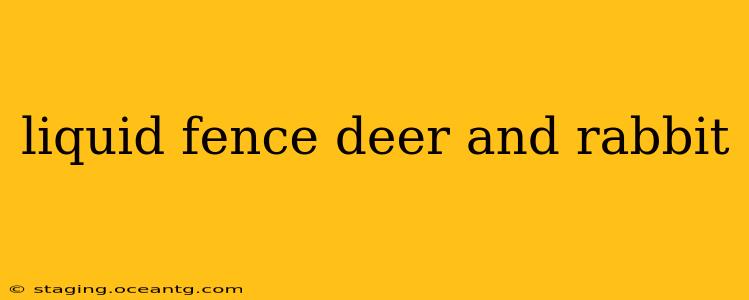Liquid Fence is a popular brand of deer and rabbit repellent, promising to keep these pesky critters away from your precious garden and landscaping. But does it really work? This comprehensive guide dives deep into Liquid Fence, exploring its effectiveness, different formulations, application methods, and frequently asked questions to help you decide if it's the right solution for your needs.
What is Liquid Fence Deer and Rabbit Repellent?
Liquid Fence is a line of animal repellents designed to deter deer, rabbits, and other small mammals from damaging plants and property. Unlike some repellents that mask scent, Liquid Fence utilizes a combination of strong-smelling ingredients that animals find unpleasant, creating a barrier they'll avoid crossing. The key is consistency in application—treating plants and areas regularly for optimal protection.
Does Liquid Fence Really Work?
The effectiveness of Liquid Fence, like any repellent, varies depending on several factors. These include:
- Animal species and habits: Some animals are more easily deterred than others. Persistent or hungry animals might be less susceptible.
- Application frequency: Regular application is crucial. Rain will wash away the repellent, requiring reapplication.
- Environmental conditions: Strong winds or heavy rainfall can significantly reduce the repellent's effectiveness.
- Scent sensitivity: Individual animals have varying levels of sensitivity to the repellent's ingredients.
While Liquid Fence isn't a guaranteed solution, many users report significant success in reducing damage. It works best as part of a broader pest management strategy, perhaps in conjunction with physical barriers like fencing.
What are the Different Types of Liquid Fence?
Liquid Fence offers several formulations, each designed for specific needs:
- Original Concentrate: A versatile option effective against a wide range of animals.
- Ready-to-Use Spray: Convenient for smaller areas and quick applications.
- Granular: Ideal for larger areas and provides longer-lasting protection.
- For specific plants/areas: Some formulations are specifically designed for vegetable gardens, flower beds, or trees. Check product labels for specific usage instructions.
How to Apply Liquid Fence Effectively?
Correct application is crucial for success. Follow these guidelines:
- Read the label carefully: Pay close attention to application rates and safety precautions.
- Apply evenly: Thoroughly coat the plants and surrounding soil.
- Reapply frequently: After rain or heavy watering, reapply the repellent. Frequent reapplication, especially during periods of high animal activity, is key.
- Target vulnerable areas: Concentrate application on areas most susceptible to damage.
- Combine with other methods: For optimal protection, use Liquid Fence in conjunction with other deterrents such as fencing or netting.
What are the Ingredients in Liquid Fence?
Liquid Fence utilizes a blend of natural and synthetic ingredients to create a repellent scent. The exact composition varies slightly between formulations. However, common ingredients often include:
- Putrescent egg solids: This contributes to the strong, unpleasant odor.
- Other natural ingredients: Often undisclosed for proprietary reasons.
Always check the specific product label for a complete list of ingredients and potential safety precautions.
People Also Ask:
What animals does Liquid Fence repel?
Liquid Fence is primarily designed to repel deer and rabbits, but it can also be effective against other small mammals like squirrels, voles, and groundhogs. The effectiveness varies depending on the animal and application.
Is Liquid Fence safe for pets and humans?
While generally considered safe for pets and humans when used as directed, it's essential to keep children and pets away from treated areas while the product is wet. Always read the product label carefully for specific safety information.
How long does Liquid Fence last?
The duration of Liquid Fence's effectiveness depends on several factors, including weather conditions and application frequency. In ideal conditions, it can last for several weeks, but reapplication after rain or watering is essential.
How much Liquid Fence do I need?
The amount of Liquid Fence required depends on the size of the area being treated and the concentration of the product. Always follow the application instructions on the product label.
Is Liquid Fence organic?
Liquid Fence is not certified organic, but some formulations utilize natural ingredients. Always check the product label for a complete ingredient list.
What are some alternatives to Liquid Fence?
Several other deer and rabbit repellents are available on the market, using different active ingredients and application methods. These include commercially available sprays, granular repellents, and homemade solutions like using human hair or soap.
By understanding the strengths and limitations of Liquid Fence and following proper application techniques, you can significantly increase your chances of protecting your garden from unwanted animal visitors. Remember, consistent application and a multi-faceted approach to pest control are your best bets for success.
